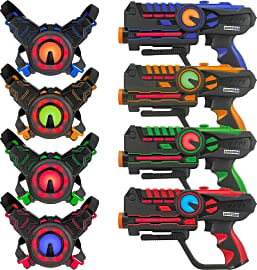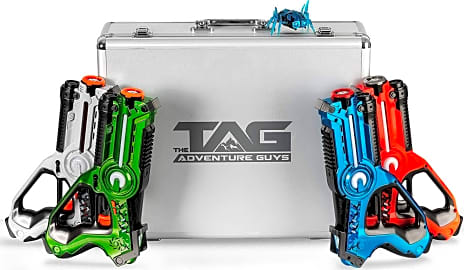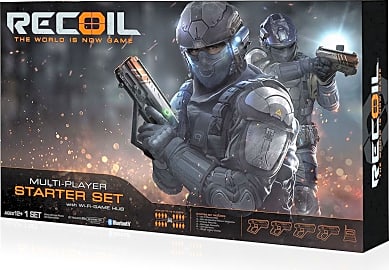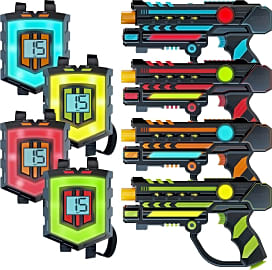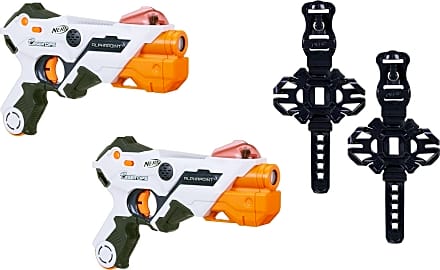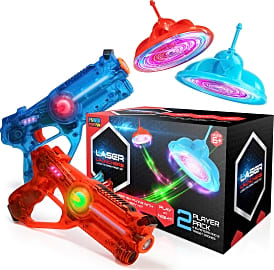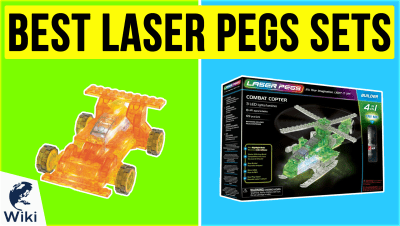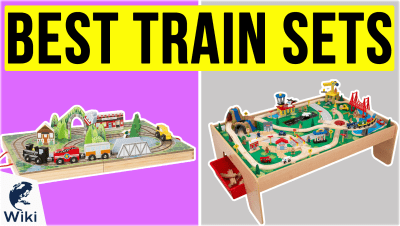The 10 Best Laser Tag Sets

This wiki has been updated 43 times since it was first published in September of 2015. Let your kids compete in adrenaline-fueled team games or wild free-for-alls with one of the exciting laser tag sets on our list. Players can blast away at their friends and siblings with safe infrared beams, experiencing the thrill of combat without the danger, as well as getting some exercise and screen-free fun. We've included options for as few as two players, though most sets are expandable. When users buy our independently chosen editorial picks, we may earn commissions to help fund the Wiki.
Editor's Notes
October 28, 2020:
The first thing that becomes obvious when looking for a home laser tag set is the enormous number of options on the market that offer the same basic equipment. There are some standouts that offer truly superior quality, like the Laser X Two Player, but at a more mid-range tier of price and performance, what really stands out are optional features that expand gameplay or enhance the experience in some way. That's why we added The Adventure Guys Deluxe, which includes a skittering insectoid robot that staggers and twitches when shot, and the Power Your Fun Launchers, which features moving aerial targets. Both sets add a new dimension to the fun, allowing players to compete head-to-head in a drone hunt or to enjoy solo play when friends aren't around.
We also included the Nerf Laser Ops Pro AlphaPoint 2-Pack, which can be paired with a smartphone app to keep track of scores and game time, and enable players to earn upgrades as they rack up kills. It also has a single-player mode based on an augmented reality game, though this does require a phone mount which for some reason is not included with the set.
One other change we wanted to highlight is our ranking for the Nerf Phoenix LTX Tagger, which was previously near the bottom of the list. In looking through customer reviews, it became apparent that this blaster is highly regarded by enthusiasts, with many noting that its accuracy and durability is higher than most. As with the other Nerf model on our list, it has an outdoor mode that compensates for interference from ambient light. It also has an innovative shield function that can temporarily stop you from both targeting and being targeted, adding an additional strategic option for quick escapes when surrounded.
We removed the Blazeray Indoor Outdoor due to reports of poor durability, and the Dynasty Toys Multiplayer Pack, which was largely redundant with several competing items but offered fewer features.
May 31, 2019:
Due to a combination of availability and durability issues, the Laser Tanks previously on our list have been removed. At the end of the day, they were on the outskirts of what could feasibly be considered a laser tag set in the traditional sense, so it wasn't too painful to see them go. Among the new additions to our ranking, you'll find the Mesixi model at number one to be particularly comprehensive, coming with everything you need to enjoy a safe, fun game. The fact that it emulates different types of weapons within the handling simplicity of a pistol is pretty special, as well. You'll also see a Recoil model added to the list, which is intended for a slightly older set of users, as it creates a three-dimensional map of your immediate area on your smartphone to create a more immersive game.
Tag, You're It!
The vest itself has its little sensors on the chest, back, and shoulders, and for some reason hits to all four spots count the same.
For anyone averse to the skin-splitting misery that is paintball or the traumatizing experience that is actual warfare, laser tag scratches your itch for combat without digging its claws in too deeply.
In a professional laser tag arena, you have to wear a miserably large, heavy plastic vest with sensors and a battery pack on it. Your gun is attached to your vest and your mobility is severely inhibited. The vest itself has its little sensors on the chest, back, and shoulders, and for some reason hits to all four spots count the same. I'm sorry, but it's much easier to survive a gunshot to the top of your shoulder than it is to your heart or your spine. That's just unrealistic.
The units we've evaluated here, by comparison, work on the same principals, but utilize much lighter and more effective technology, allowing you greater mobility and a more realistic game.
The biggest difference between the big laser tag operations and the games you play at home is that the home systems don't use the kind of lasers the pro systems do. Professional laser tag vests use a laser similar to what you get when you buy a laser pointer. Home systems, however, operate on the same infrared technology that you use in your television remote control, which is a little more forgiving of your shot accuracy, but also a lot weaker in its signal.
While some systems still use vests (which are much smaller and lighter than the vests of yore), the majority of laser tag systems out there use a small sensor built onto the gun itself. The advantage of this little sensor living on your weapon is that it requires you to purchase, organize, and power fewer pieces of hardware. The disadvantage is that it's a little easier to block incoming shots with your hands if you've got a cheater for a friend.
For The Love Of The Game
Laser tag has always been about the purity and simplicity of the game, and that game is a combination of interpersonal warfare and capture (or destroy) the flag, with two to four groups at odds against one another, each group responsible for protecting one or more large sensors situated at strategic points around the arena.
You have to form actual tactics with your team if you want to win, and that includes drawing the defenders of a given target away from their positions so you can hit it with as many shots as possible. The more shots you nail against the target, the more points for your team.
Some of these sets come to you in all their splendor right out of the box, but take a close look at each with specific regards to what you're going to get.
If you like that target system, and you want to recreate it at home, that significantly narrows down the sets on our list that would be perfect for you, as only a couple of them have available target points for their games. That said, all you really have to do to create a similar experience is buy an extra gun for each side and set it up as an immobile target that each team must protect.
Some of these sets come to you in all their splendor right out of the box, but take a close look at each with specific regards to what you're going to get. There are sets out there that come with almost everything you need, but that intentionally leave out a key element (like a second target) for you to buy separately. And certain truly complete systems are either too complicated, too expensive, or both, and either could be a deal breaker if the customer in question is a kid.
The only other thing to consider, and this has more to do with your intended spaces that anything else, is infrared range. A few of these guns very honestly advertise a usable range of up to 30 or 40 feet, while others claim effectiveness and accuracy at distances of over 200 feet. Those latter claims seem inflated, and in our testing, greater distances and more numerous obstacles (like trees, for example) exponentially decrease performance.
War Games Brought To Market
In case you ever find yourself on the verge of looking up the birth of a given technology, there's a pretty high chance that you could save yourself some time by just assuming it was made by the military. From the internet to LSD, the military has brought us some astounding technologies over the years, and laser tag is another on that long list.
Since the soldiers in training couldn't feasibly cover themselves head to toe in infrared sensors, the system failed to accurately recreate a battlefield scenario.
In the late 1970s, the US military developed a system of infrared laser combat devices for training purposes. The disadvantage of these, of course, was the limitation of target realism. Since the soldiers in training couldn't feasibly cover themselves head to toe in infrared sensors, the system failed to accurately recreate a battlefield scenario.
The first toy company to make use of the technology didn't have laser tag in mind, however. Milton Bradley produced a phaser toy modeled after the weapons on Star Trek, which hit the market in 1979 and utilized the tech that would become laser tag. Within about a year, two other companies jumped on the design, creating the team-based sport of it.
Laser tag arenas cropped up in arcades at a steady clip throughout the 1980s and 90s, with popularity waning some as that generation moved on to other pursuits. As those early players have had children of their own and sought out a little bump of nostalgia, arenas have begun to reopen around the country.



